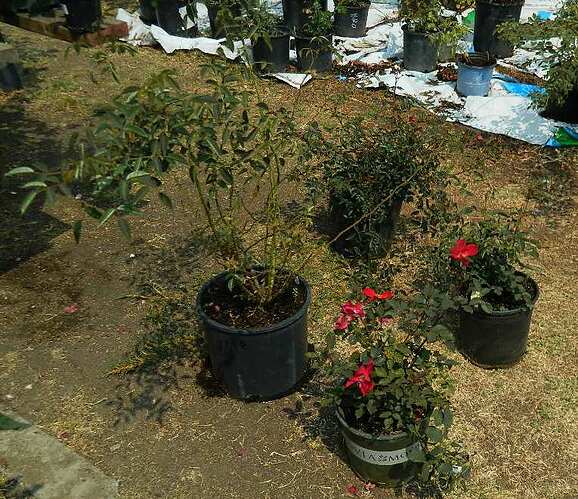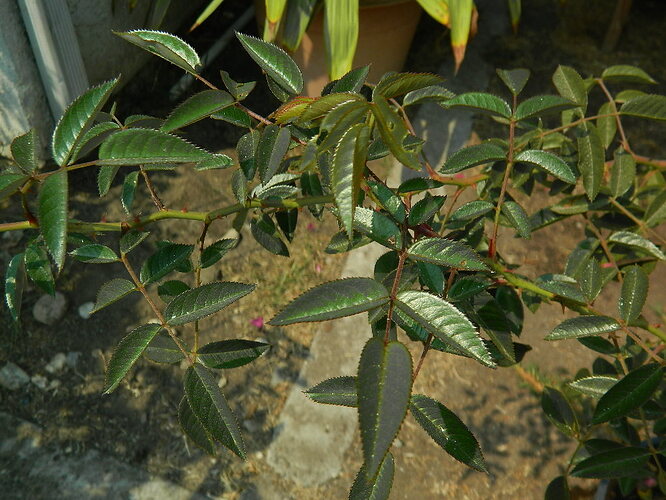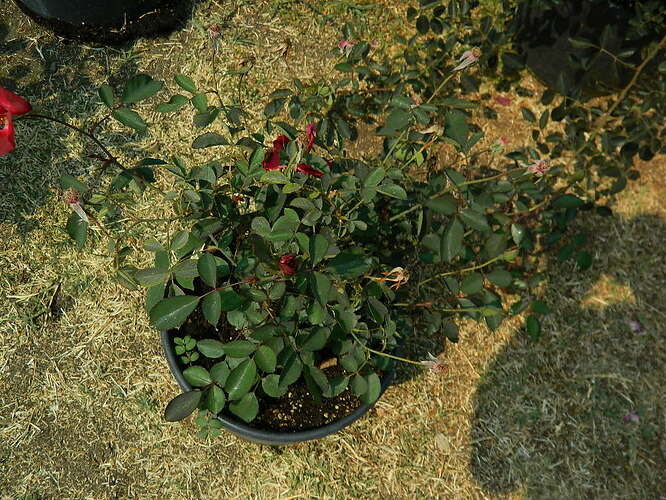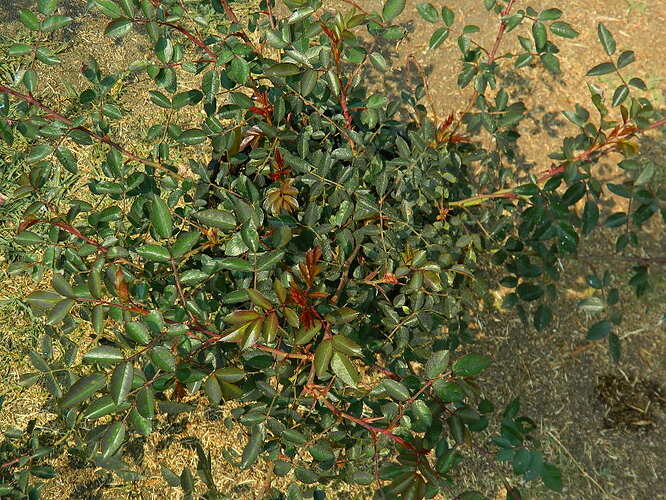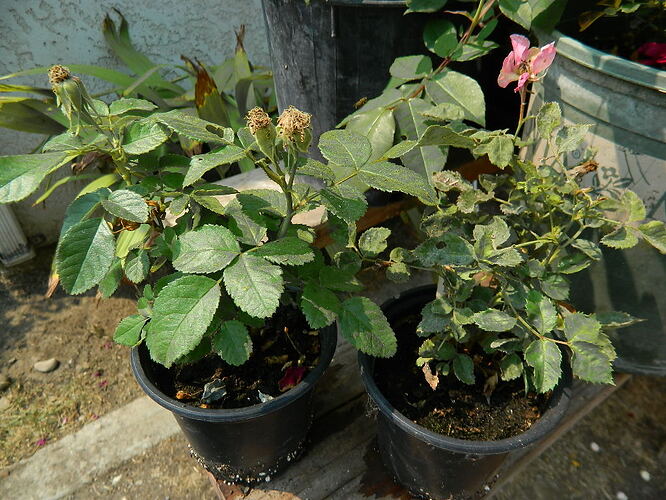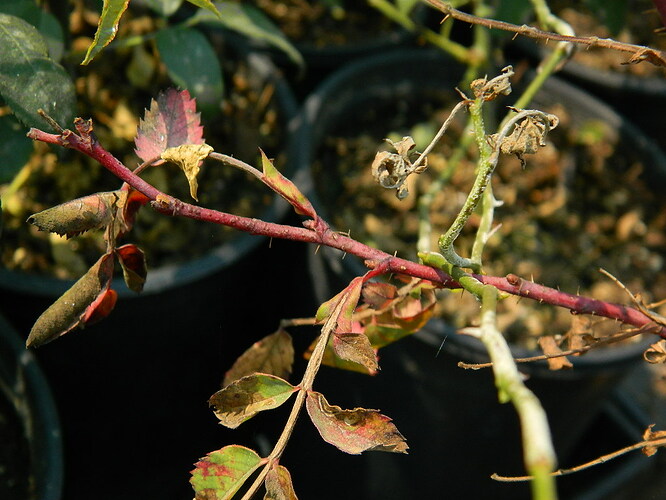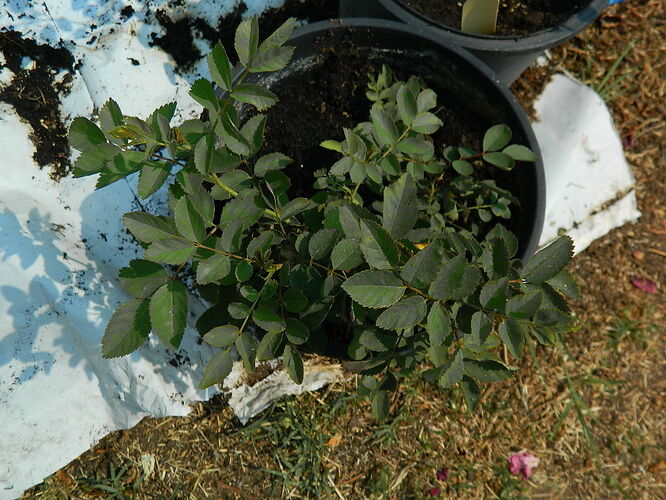Jon, it’s been raining here like a cow on a flat rock! Take a look at the photos I posted today on HMF of how Minutifolia “traps” water with those “hairs”. Kim
It’d definitely be a good way to receive water in high desert – 2am to 6am dew. The stems looks familiar, by the way, but I cant place it. If I could recall then maybe that’d help in understanding its culture.
Kim that does make since on the fog in relation to R. minutifolia. Right now I got one growing inside under lights. It has grown quite a bit. I water it about four times a month with a shot glass full of water but I do mist it once a day. I do the same thing with several succulents (but with a little less water) and I figured it would respond well to this and so far so good.Oh by the way the potting soil is 1/3 regular potting soil, and 2/3 potting soil designed for succulents so it drains well. the regular potting soil does have a little fertilizer but the succulent potting soil does not have any in it. I have not fertilized mine at all. Oh by the way outside the foliage burns a little bit in hot sun. I think it is probably an under story plant growing under other shrubs or something in the wild. Also I tested out very very weak pesticide on one stem out of curiosity and it does not like that at all. I hope that helps you out Jon.
It would likely be better as an understory plant in hotter areas, Adam. In the old garden, it was shaded by huge lilacs, and much larger roses. It did receive hot sun, but not for hours and hours. Stellata received that also, and it ate many square yards each year. The most prolific year for Minutifolia was the year when it grew vigorously in a can then hopscotched into seven others, forming new plants and then taking off again.
I can’t add anything other than that I’ve had a number of plants crisp up and die as if over-fertilized after planting in various Miracle Gro potting soils in the past; it seemed like there were high salt levels, or something similar going on. I completely abandoned using that brand’s regular mixes as a result (I did keep using their Organic Choice mixes until they were reformulated with what seemed like fairly substantial amounts of wood chips, presumably to add bulk and reduce cost). Can’t say I’ve tried the Moisture Control mixes, but I’ve pretty much given up on all of their planting mixes now.
Thanks for the heads up, Stefan. I haven’t used their other products. I only spring for the Moisture Control because of the coir base and that it honestly does hold things through longer in the high heat here between waterings. The fertilizer in it seems to be rather good for everything I’ve planted in it, from roses to lilacs to various tree seedlings. I haven’t had any issues with it yet. Kim
Not to dwell overmuch on a boring topic, but whenever you buy something with fertilizer added, you are likely getting the cheapest which these days is urea, which itself is toxic to plants, accumulating in the leaves giving salt burn, and also making ammonia which is even more toxic. You must have a way to convert that urea to something safe. For most plants that means nitrate. that in turn means you need nitrifying bacteria, which so far as I know are not added deliberately to these formulated mixes. Only garden soil which has been fed sources of ammonia will have a starter culture of them. I always blend in some soil with peat mixes for this reason. Of course that runs the risk of getting bad fungi too.
Some kinds of plants can tolerate more of the urea and even deal with it themselves, like soybeans, or tomatoes. But a wild rose that only knew N limited soils in its native habitat is probably going to be really unhappy.
Some members of the Rosaceae have nitrogen-fixing organisms associated with their roots, and most will almost certainly have a lot of mycorrhizae fungi that help them take up phosphorus. So they can do quite well with very low available nutrients. High levels may kill off these symbionts which do other things to benefit the plant, such as improving water acquisition, or providing growth hormones. Probably no one has ever studied this for stellata, or minutifolia, or H. persica so I can’t say if its true or not. But certainly consistent with their native habitat.
The company I used to work for used generic osmocote. The guy that ordered it would probably sell his children to the highest bidder only to use the profits for sales at a bargain bin, if that gives any ideas of ethics involved in these types of decisions, lol. I really cannot stand some of these practices but they do what is the most efficient, and then pass the cost off in some way to the consumer, the plants and the environment. Urea is awful, awful, awful. It totally trashes prime agricultural-grade land.
The funny thing, though, is that the local govt agency had a thriving Bald Eagle population going. It was pretty awesome ![]() The eagles, though…lol… would drop their used fish carcasses in the water holding ponds used for irrigation. So if you got wet by the sprinklers, you’d smell like fish. I wonder if the plants liked it, LOL!
The eagles, though…lol… would drop their used fish carcasses in the water holding ponds used for irrigation. So if you got wet by the sprinklers, you’d smell like fish. I wonder if the plants liked it, LOL!
R.stellata mirifica - anyone? I am much too timid to really have a go with species roses but they are, far and away, my first love…and stellata is one of the most interesting. I do not want to wander very far from this basic five-petalled form. East Anglia is semi-arid - by far and away the driest part of the UK - even winter rain, the bane of many tender plants, is rarely a big issue on our free draining, fertile fen soil.
Suzan, go for Len’s Pink Mystery instead. Having grown both, it offers MORE bloom, LARGER blooms, denser foliage with all the look and feel of Stellata. Think Stellata on steroids, run through Hollywood. Maybe not THAT bad, but it is a gorgeous plant, a continous (here) flowering cross of Stellata, Nutkana and Bracteata.
They sent it to me years ago as a “thank you” for garbage bags of cuttings I sent over with a friend who was visiting her son and grandchildren there. I spread it as far and wide as I could get people to take it and now it seems lost in this country. I WANT this one back! Bierkreek had it but not currently. Not even Lens is offering it this year. We can’t let this one disappear!
Kim
Probably not new news here, but the Curator of the Peggy Rockefeller Rose Garden in his presentation at the GROTW yesterday, included a blurb on “sustainability” and showed graphs stating there have been eleven populations of black spot identified around the world. We have three here. They’ve tested a limited number of cultivars against all three. Only Applejack is highly resistant to two of the three. I didn’t notice any of the ones shown to be resistant to the third.
He also stated by State law, they can’t really spray. Through replenishing the soil to make it more “alive” with beneficial organisms, and replacing offending cultivars with more resistant ones, the grade of the garden went from 23 - about 86% healthy roses in around three years. Interesting, not about selecting the right rose for the right climate (been preaching this for years!), nor about properly creating “soil” instead of planting in dirt, but about the eleven populations and Applejack.
Telling people soil has biomes is trying lol. I get blank stares and “He’s nuts …” looks ![]()
This is reviving a really old and long thread. From a totally novice, newbie perspective, at least in terms of breeding, aren’t ancient cultivars, such as Autumn Damask, closer to species but have had many of the kinks ironed out? With the proper investigation, could they be used to introduce the desired species traits? Also, where double forms of species have been selected, might they also introduce species vigor without having to eliminate undesirable traits through generations of back-crossing?
You would hope “some of the kinks” have been worked out. But, that highly depends upon climatic suitability. Even Autumn Damask has specific requirements to keep it healthy. When grown in too long, too hot and too arid a climate, it suffers greatly from rust and black spot. Where the season is the right length and temps appropriate, it remains quite healthy. The same holds true for every other class of roses, old or new. In hot climates, Banksiae and Fortuniana are rudely healthy. Growing them here where it is a ‘cooler beach’ climate, there are rather extreme disease issues (moderate to severe mildew and some black spot). We may be able to affect some improvements, but there will always be rather great “Achilles’ Heels”.
Steven;
I’ve been trying just the approach you bring up, and not all of the results were good, but I’ve found some quite encouraging.
Half of my posts over the last few years have included complaints about drought, and the hungry wildlife it brought into my yard. Most of my roses also got insufficient sunlight, and couldn’t be given fertilizer since nitrogen would increase their thirst. The water stress was enough to keep most of what I was growing visibly sick for most of the year, with some combination of mildew and rust, along with lesser amounts of blackspot and anthracnose. I really torture tested them, and I had seedlings dying in droves. Grandma’s Hat, for example, went from about 40 seedlings to one lone survivor, and most other garden cultivars did no better. Then I moved to a new location which was several degrees warmer, where they got full sunlight for at least 8 hours a day, and sat on hot concrete. Most ended up with a bad case of sunburn, and are now dropping and replacing their foliage.
But two groups of my seedlings survived at much higher rates than the others: those of Single Musk and Autumn Damask. I do think that their closeness to species makes them tough, and they don’t seem to care about fertilizer, or want much water. While most of my roses still look too awful for me to want to post any pics of them, some of those seedlings, like this one of Autumn Damask, have been doing really well.
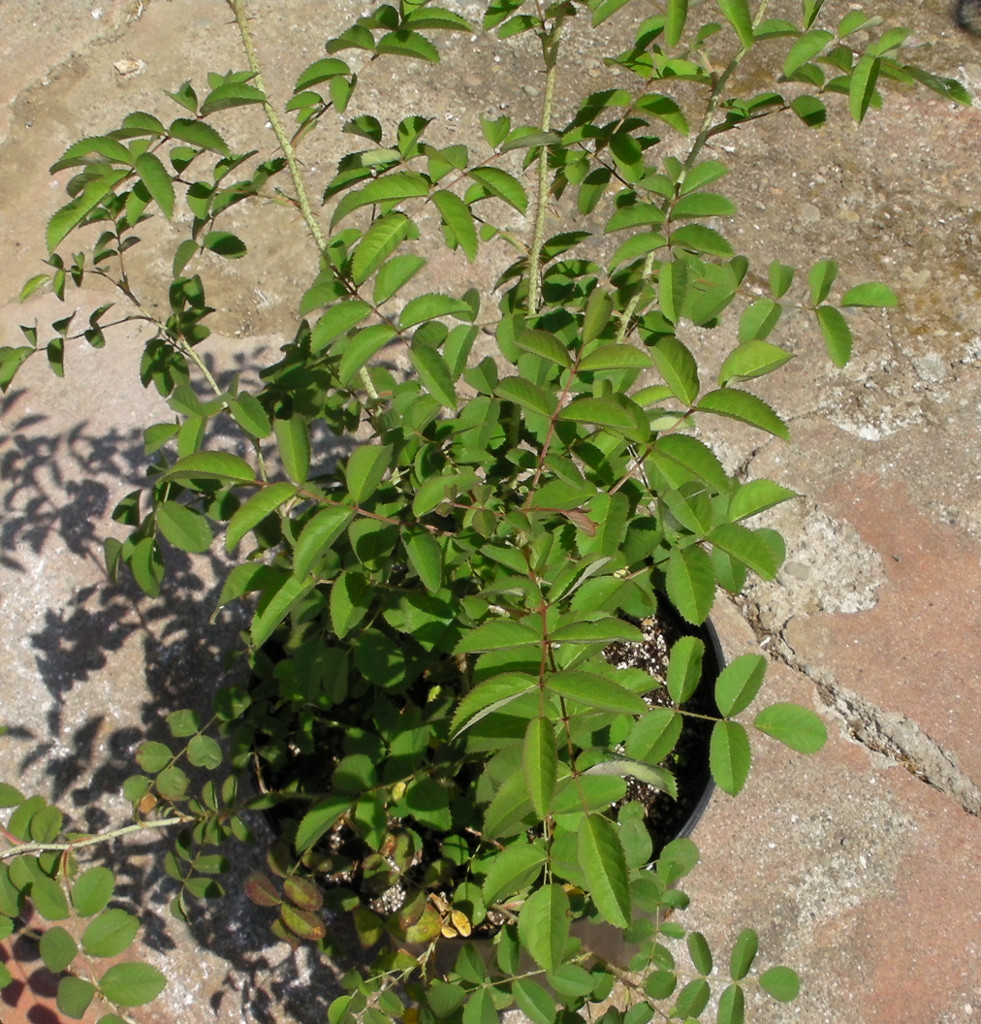
(Nine leaflets, the fedtschenkoana is strong in this one! It’s very vigorous, growing about 4" a week in a 3g pot, while most of the garden is in stasis.)
Nature has kept wild roses tough by relentlessly killing off all that were weak or reproductively impaired in the exact environment where they happened to be growing, with zero regard for anything else. Breeders got the things they were selecting for, and tended to lose whatever they did not select for. Garden roses did not have to be tolerant of drought or poor soil, they didn’t have to be vigorous, they could be virtually sterile, or have such bad root systems that they wouldn’t do well without grafting. I think that all of those problems can be overcome by going closer to species.
But, as pointed out above, every rose is bad somewhere, including species roses and simple hybrids, and there’s really no way around that.
Nature has kept wild roses tough by relentlessly killing off all that were weak or reproductively impaired in the exact environment where they happened to be growing, with zero regard for anything else.
Agreed. “Natural Selection” and “Evolution”. Precisely what you have consciously done with your “unnatural selection” and breeders have done for generations with theirs. The difference is, you have selected for vigor and health, “success” in your hot, exposed conditions, rather than for the “pretty face”.
Breeders got the things they were selecting for, and tended to lose whatever they did not select for. Garden roses did not have to be tolerant of drought or poor soil, they didn’t have to be vigorous, they could be virtually sterile, or have such bad root systems that they wouldn’t do well without grafting.
Nor really even acceptably “disease resistant” where they were tested, much less across widely varying climates and conditions. Even when a few have been found to be, it has only been to one type or a few races of a specific type of disease. Knock Out resists multiple races of black spot in many areas, but it also mildews and rusts terribly in various places. Dr. Lammerts proclaimed Maytime “Immune to powdery mildew”. In every climate and in all conditions I have ever observed and grown it, his proclamation appears to hold true. But, it can also black spot in my places too. Many Basye’s Legacy offspring are highly black spot and mildew resistant, but many also rust like old iron skillets.
I think that all of those problems can be overcome by going closer to species.
Ah, here is the rub. I applaud your results. They are very attractive and appear to have some improvements in vigor, beauty and resistance, but very similar results and observations can be, and are being experienced without any direct species use. I have sibling seedlings (same mate, same breeding and germination year, grown in the same soil, side by side in the same conditions) between moderns and Grandmother’s Hat which have varied quite widely, as you’ve experienced. Several which I have retained, also vary greatly in vigor, repeat and health. All have very attractive foliage. One has struggled with downy mildew and is probably now struggling with too small a container, inhibiting its ability to replace foliage. It hasn’t flowered yet. One is growing quite well, has remained completely healthy and also has yet to flower. One repeats continually with lovely foliage, that rusts much too easily for my tastes. The fourth repeats, has lovely foliage and has remained completely healthy here. No downy, no rust. None of them have mildewed and the very few leaves to have experienced any “spotting” are easily attributed to being overly crowded, raising and retaining the humidity higher than would otherwise be experienced.
L56-1 X Grandmother’s Hat
DSCN5098.JPG
Tall seedling
Rusty seedling, front left of photo
Healthiest, repeat flowering seedling, bottom right of photo
Healthiest seedling yet to flower, top right of photo
These are also siblings, identical everything. (L56-1 X Indian Love Call) X Manhattan Blue, stressed in four inch pots for the past year. Both have vigor, both repeat, only one has health (at least here).
Fedtschenkoana crosses are also widely variable here. I was able to grow Fedtschenkoana in full sun (canned) in Encino, Zone 10a, with coastal influence at night and inland valley heat during the day. Here in Zone 9a, strong marine influence day and night, its foliage will not tolerate the UV. I must grow it under the trees (same can and soil) or the foliage bleaches out, burns and dries out. The results it can produce depend entirely upon the selected mate.
L56-1 X Fedtschenkoana
(Midnight Blue X Fedtschenkoana) X self, the only retained seedling of the bunch as it is the only one to hold its foliage…at all.
R. Arkansana “Peppermint” foliage now.
Lynnie X R. Arkansana “Peppermint”
Your results are great and I do applaud you for doing more exploration with species. I propose, however, your selected results are better attributed to both the “luck of the draw”, and equally to astute observation and selection. I would be far more willing to attribute the successes to utilizing species if their use had produced a high percentage of successful seedlings in your test. You lucked out with some successful combinations, but you observed and selected them, as you did with the results of the other crosses. Both types can vary greatly. The specific species seedlings you selected succeeded simply because they inherited the necessary gene sets they require to endure your conditions. The same can easily be found true from modern X modern or even modern X OGR crosses, as long as they, too, benefit from “the luck of the draw”.
I’m replying only to the last paragraph, since we’re on the same page up to that point. I think that going closer to species is a way to breed tough roses, but absolutely didn’t mean to suggest that it’s the only way. And going back to a species that does badly where you live, might be no better than crossing with a garden rose that does badly there. That almost all of my Grandma’s Hat seedlings mildewed and died was not that big of a surprise, since nearly all Bourbons get sick here, including GH. But I had problems with seedlings of other garden cultivars as well, and I do think some of those were the result of selection for beauty over robustness. Like when breeders started valuing rebloom over most other factors, and produced roses like La Reine and Reine des Violettes, which required richer soil and more water than the roses which they were replacing. Those were tradeoffs made knowingly and willingly, and they can be bred back out, though not necessarily with more of the same. My moderns which survived their ordeal looking better than average were things like Bonica, Iceberg, Lynnie and ALMD, all of which have departed from the chinensis mainstream and been crossed with species which do better here.
Sometimes I’ve bashed chinensis for how much it mildews for me, mildews at SJHRG, and most places in the area. And a lot of its HP descendants do the same. Yet my drought observations now make me wonder if the mildew wouldn’t be significantly reduced if those chinensis-based plants got twice as much water as the others. Of all Bourbons, early Chinas and Teas, Ragged Robin is almost alone in being quite healthy here, but it has a famously effective root system. I don’t think it could be a great rose here without those roots. But I digress.
I’m forced to disagree here, because you’re giving me a lot of credit for selection, when my only criterion was, “Is it dead yet?” Over two thirds of my seedlings were killed by drought and/or disease, and maybe another 10% (regardless of health) by varmints. I’m growing out everything that survived, if only to see what happens. Much of the process is a crapshoot, and every rose will have some sickly seedlings, just as you say. That most of my musks survived, and close to as many of the damasks, while others had attrition rates of well over 80%, may only mean that I chose my more complex garden hybrids badly for the environments they were subjected to. I haven’t been breeding moderns, since there are so many skilled people with more resources than me doing that, and figured the only way for a hobbyist like myself to contribute anything useful was to find niches that nobody else cared to explore. Bonica x Lynnie might have done as well as any species crosses I made, and the fact that I didn’t try anything like that, surely skewed my results.
So I’ll just clarify my original assertion, and say that I believe crossing a species which is good where you live, with reasonably compatible mates, is one way to get tough roses. It is a hairshirted way, requiring 3-6 times as long as working with most garden roses, and the lack of rebloom will mean that no gardener will be interested in your F1s, so it’s an approach that won’t interest most breeders. But if one’s very patient and/or masochistic, or fancies once-bloomers, it can work.
I’ll conclude by correcting something I said earlier, which was that only 1/40th of my GH seedlings survived. That was true of those where GH was the seed parent. One of my other survivors looks to be (Autumn Damask x Grandma’s Hat), and while it doesn’t have remarkable vigor, it’s sturdy and disease free. Its lack of rebloom will make it worthless as a garden rose, but I’ll cross it with rebloomers in the hope of getting heritable remontancy in a rose which still has Damask character and scent. That last sentence will doubtless have some rolling their eyes (OMG! He wants to reinvent HPs!), but I like trying things which nobody else wants to do, and think the class deserves a do-over focused on health under 21st century conditions. And for that, modern x modern will never get me there.
Pierre,
I have just one quibble: Many of the alleged descendants of Park’s rose (Ochroleuca) are actually derived from ‘Knight’s Yellow China’ (Flavescens), a self-seedling from the Blush Tea-scented. The two yellowish roses were already confused by the 1830s, and Knight’s rose was largely forgotten by later writers, even though it continued to be cultivated long after Parks’ fell out of favor (at least in England) because the flowers rarely opened well. ‘Smith’s Yellow Noisette’, for example, was almost certainly bred from Knight’s Yellow China. And as a parent of ‘Devoniensis’, ‘Smith’s Yellow Noisette’ contributed to some early HTs (e.g., ‘Lady Mary Fitzwilliam’).
This fact does not take away from your main point, though. It merely shifts some of the burden to the Blush Tea-scented, which also strongly influenced modern roses.
Crossing our cultivated roses with species should increase genetic diversity, but perhaps not as much as we would like. One major problem is gene linkage.
Suppose we cross a diploid yellow Tea rose with a hardy Synstyle species (helenae, wichuraiana, multiflora, setigera, etc.), then cross among the progeny. In the F2 we then select for large, yellow flowers, borne continuously and few to the cluster, on plants that are nearly as hardy as the species. Will we be able to select a hardy yellow Tea?
Linked genes are usually not related in their functions. When selecting for large flowers, we are relying on the Tea parent to contribute all the genes responsible for this trait. But we will also be bringing along many unrelated genes that are linked to those selected genes. The same is true when we select for yellow coloring. Many linked but functionally unrelated genes from the Tea parent will also be brought along into our new selection. Doubling presents the same difficulty.
Furthermore, the hardiness of the species will also drag along many genes from the species that may not be so desirable in a garden rose. We won’t know which genes, or how they influence the progeny, until we make the crosses. For example, it sometimes happens that the “everblooming” trait is inherited by some of the F2 progeny, but these plants don’t start blooming (and reblooming) until the second or third year. The precocity (early bloom) that we expect in our garden roses can be diluted or lost in outcrosses to species.
One way around these problems is to domesticate the species before crossing. Some species have produced double-flowered selections, color varieties, etc. These could be used for breeding rather than random, typical specimens of the species. For example, if we are aiming for a new variety with double red flowers, we could start by crossing a red-flowered variety of a species with a double-flowered selection of the same species. We could then select among the progeny for precocious bloom (i.e., plants that flower in the 2nd year rather than 3rd of 4th). And then, with a double red, precocious flowering plant, we begin crossing with double red HTs, HPs. Floribundas, Polyanthas, or whatever. In this way the species is allowed to contribute many more genes than would be possible if we had to rely on the cultivated parent for all the genes necessary for deep color, floral doubling and precocity.
A practical example of this approach is Burbank’s Giant Maritima plum. Regarding the wild Prunus maritima, he wrote:
“It is one of the hardiest of all known wild plums, and habitually productive. It is a low, compact bush, rather than a tree, with rough, even thorny, branches, and small dull green oval leaves. The flowers are small, but are produced in great profusion, making it almost worthy as an ornamental plant. The fruits, as I have said, are small, usually less than half an inch in diameter; and they are bitter, being almost or wholly inedible unless cooked—yet making excellent preserves.”
But domestication made a difference.
“I had been growing seedlings of the Beach plum by the hundred thousand. By continuous selection I had produced varieties bearing fruits nearly an inch in diameter, of a pleasing form and color, of delicious flavor. The trees, moreover, had almost incredible productiveness together with increased size and vigor.”
He then crossed one of his improved selections with a cultivated Japanese plum. In the 2nd generation he raised a new plum with fruit sometimes 8.25 inches in circumference.
http://bulbnrose.x10.mx/Heredity/Burbank/BurbankMaritima1914.html
Kim, Hardy and Karl. These are all great and stimulating comments.
My latest idea is to cross fedtschenkoana with Red Damask and Autumn Damask, which, according to HelpMeFind, are pollen seedlings of fedtschenkoana, and most likely not closely related to each other or to the individual fedtschenkoanas available today. Then select the most double and most remontant seedlings and cross them back with the damask that wasn’t their parent. I’m thinking that since the two damasks are thought to be half fedtschenkoana from ancient sources, they would be good subjects for experimentation with species fedtschenkoana. I’m wondering if, since the two damasks are half fedtchenkoana, their pollen might induce fedtschenkoana to produce viable seeds. I also would like to cross the two damasks with each other.
With persistence, both the first and second generation crosses should produce results, that, if not fantastic, are at least interesting. I mostly would be doing this for my own curiosity, since the likelihood of producing commercial varieties is slim to none. But they could be breeding stock.
My big limitation is space. I live in Washington, DC, and am moving into a townhouse. I won’t have much of a yard and don’t want to inflict suckering monsters like fedtschenkoana and Red Damask on my neighbors, so I’m going to experiment growing them in large pots. From what I read, Autumn Damask should be well-behaved enough in the ground. If I can, I want to try to keep them short, since DC appears to be ground zero for rose rosette disease, and I don’t want them to be big flags for the mite that carries it.
I’d also like to cross all of these with R. kordesii, if I can get ahold of it. Does anyone know how I can do that? There doesn’t appear to be a commercial source for it.
Hi Steven, perhaps your climate may help tame them into condescending to remain potted? That doesn’t work too well in the “land of endless summer”. It’s sad how something which was once fairly easily obtainable, “suddenly” disappears, isn’t it? At least there are a number of first generation seedlings from Kordesii still around. Help Me Find lists two previous sources of Max Graf who may be able to provide plants of that, if you wanted to substitute it for Kordesii. I will be at the San Jose Heritage next month and can look to see if they still have Max Graf there.
